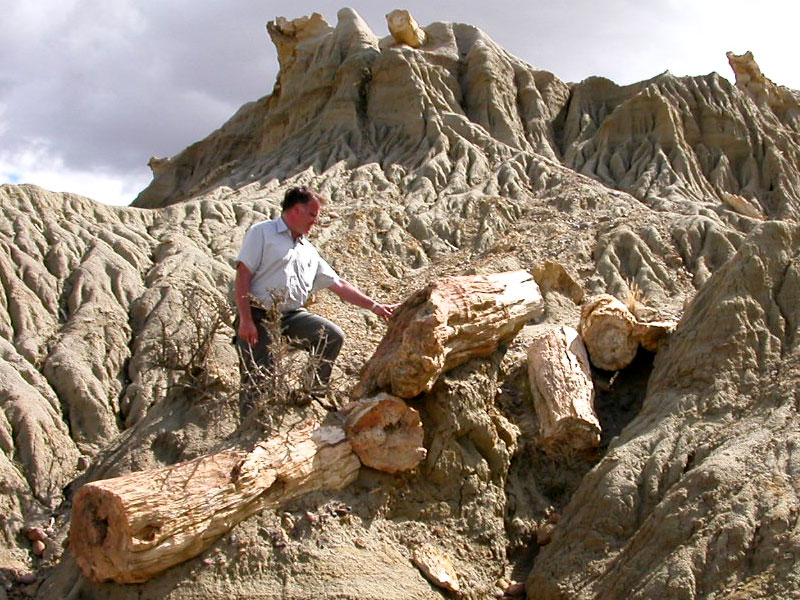
Credit: Dhzanette, public domain, via Wikimedia Commons
Have you ever seen the brilliant hues of petrified wood and wondered how it gets its colors?
When trees die, they typically fall to the forest floor, where they decay.
But if they fall in a place without oxygen—in water, a swamp or bog, or are buried by volcanic ash or flood silt—they may not decay.
After thousands or millions of years, water seeps into the pores of the wood, carrying dissolved silica. The silica bonds with the cellulose and replaces it.
Then other mineralized water enters the silica–cellulose framework, where those compounds replace the rest of the organic material.
We’ve found nearly 40 minerals in petrified wood, many containing iron, manganese and chromium, which provide its spectacular red, orange and blue colors.
The lithification process also preserves the physical structure of the tree, sometimes down to the microscopic level.
Eventually, erosion exposes the fossilized logs—some dating back over 300 million years for us to discover...
And they’ve helped us study the long history of tree evolution while providing valuable information about the environmental conditions of the ancient past, such as rainfall, drought, fire and insect populations.
Petrified Forest National Park in northeastern Arizona is one of the most famous sites. Definitely worth a trip, especially in the spring or fall when temperatures are mild, to find beautifully colored windows into the past.
Background
Synopsis: When trees are fossilized, they become petrified wood. It forms when organic tree tissue is buried and mineralized, turning into rock. Throughout geological time, petrified forests have been preserved in floodplains and deltas that were suddenly inundated by silica-rich volcanic debris flows and ash beds, freezing these ecosystems in time.
- Petrified wood is wood that has been turned into stone—fossilized. The term originates from the Greek root petra, which means stone.
- When trees die, they typically fall to the forest floor to be rapidly decomposed by microorganisms in the presence of oxygen, returning nutrients to the forest floor.
- But if oxygen is limited or absent, aerobic microbes can’t do their work, and trees are preserved as they are buried.
- These conditions occur if trees are rapidly buried in mud carried by floodwater, if they are engulfed in silica-rich volcanic ash or debris flows in the aftermath of volcanic eruptions, or if they fall into deep oxygen-poor pools of water.
- Wood may petrify very quickly if it falls into hot springs, like those in Yellowstone.
- Typically, after millions of years of burial, silica dissolved in groundwater circulating around the tree mineralizes some of the organic material in the wood while retaining the structure of the wood, producing a durable 3D fossil that may even preserve the appearance of bark and xylem.
- Nearly 40 minerals have been identified in petrified wood, but silica minerals are the most common because they form hydrogen bonds with cellulose in cell walls.

Polished petrified wood showing silicified xylem tissue.
Credit: Wilson44691, public domain, via Wikimedia Commons - After the framework of silica forms along the cell walls, minerals slowly fill the spaces that remain. Only about 10% of original organic material remains.
- The organic material can be replaced by silica (opal or quartz), pyrite or calcite.
- Most of the color in petrified wood comes from trace elements like iron, manganese and chromium.
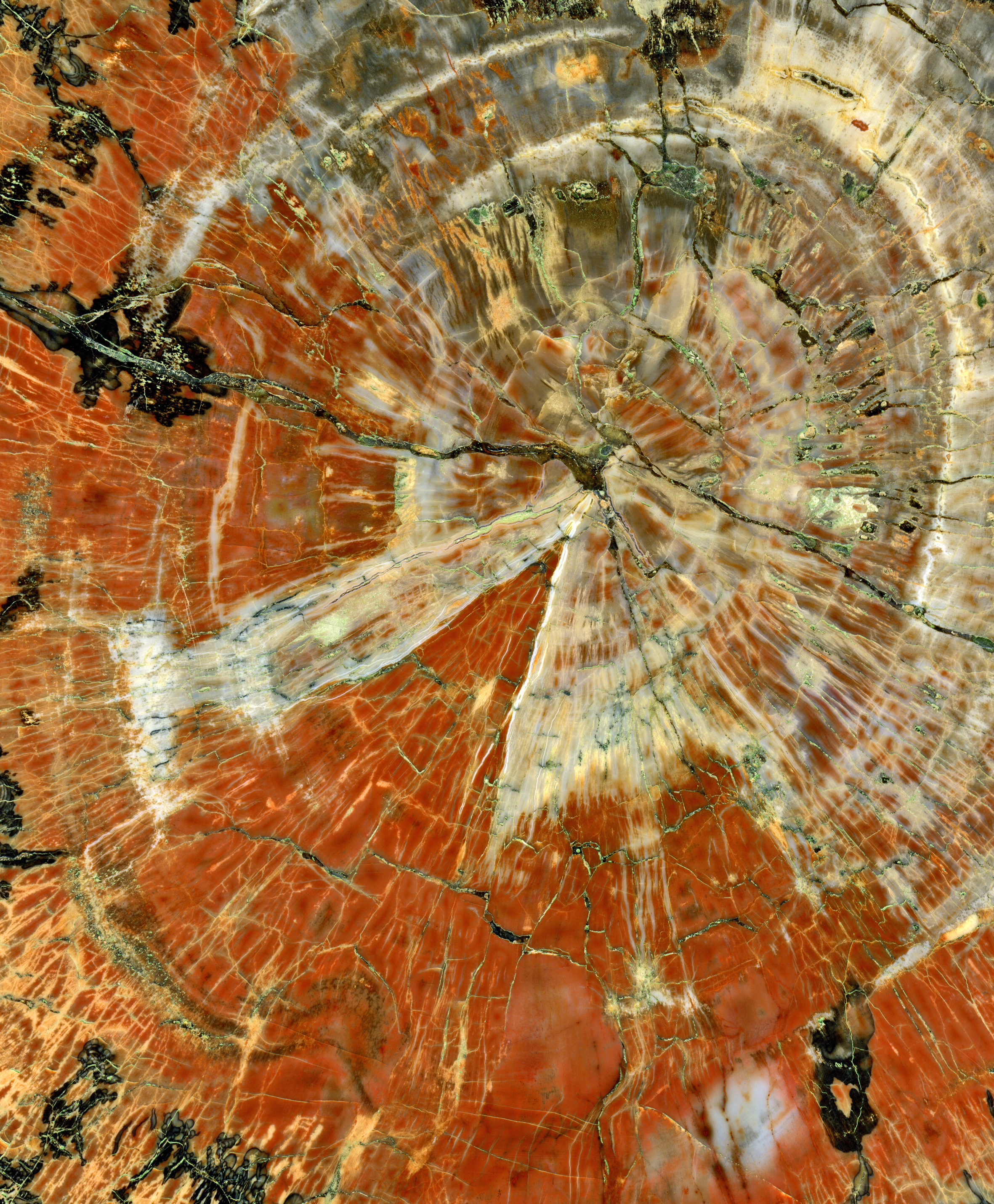
The colorful center of a polished slice of a petrified tree from Petrified Forest National Park, Arizona. If enlarged, it is possible to see insect borings in the wood that were made approximately 225 million years ago in the Late Triassic.
Credit: Michael Gäbler, via Wikimedia Commons - Over time, erosion exposes fossil logs, sometimes exhuming entire fossil forests.
- Nearly 40 minerals have been identified in petrified wood, but silica minerals are the most common because they form hydrogen bonds with cellulose in cell walls.
- One of the most famous petrified forest localities is in Petrified Forest National Park in northeastern Arizona about 26 mi (42 km) east of Holbrook along Interstate 40.
- In the Late Triassic Period, 225 million years ago, the area was a dense tropical forest with 200 ft (61 m) tall trees with diameters as large as 9 ft (2.75 m).
- River flooding inundated the forest with mud, toppling the giant conifer trees.
- The area was blanketed in volcanic ash from nearby eruptions, providing a source of silica that enriched the groundwater, slowly mineralizing the trees.
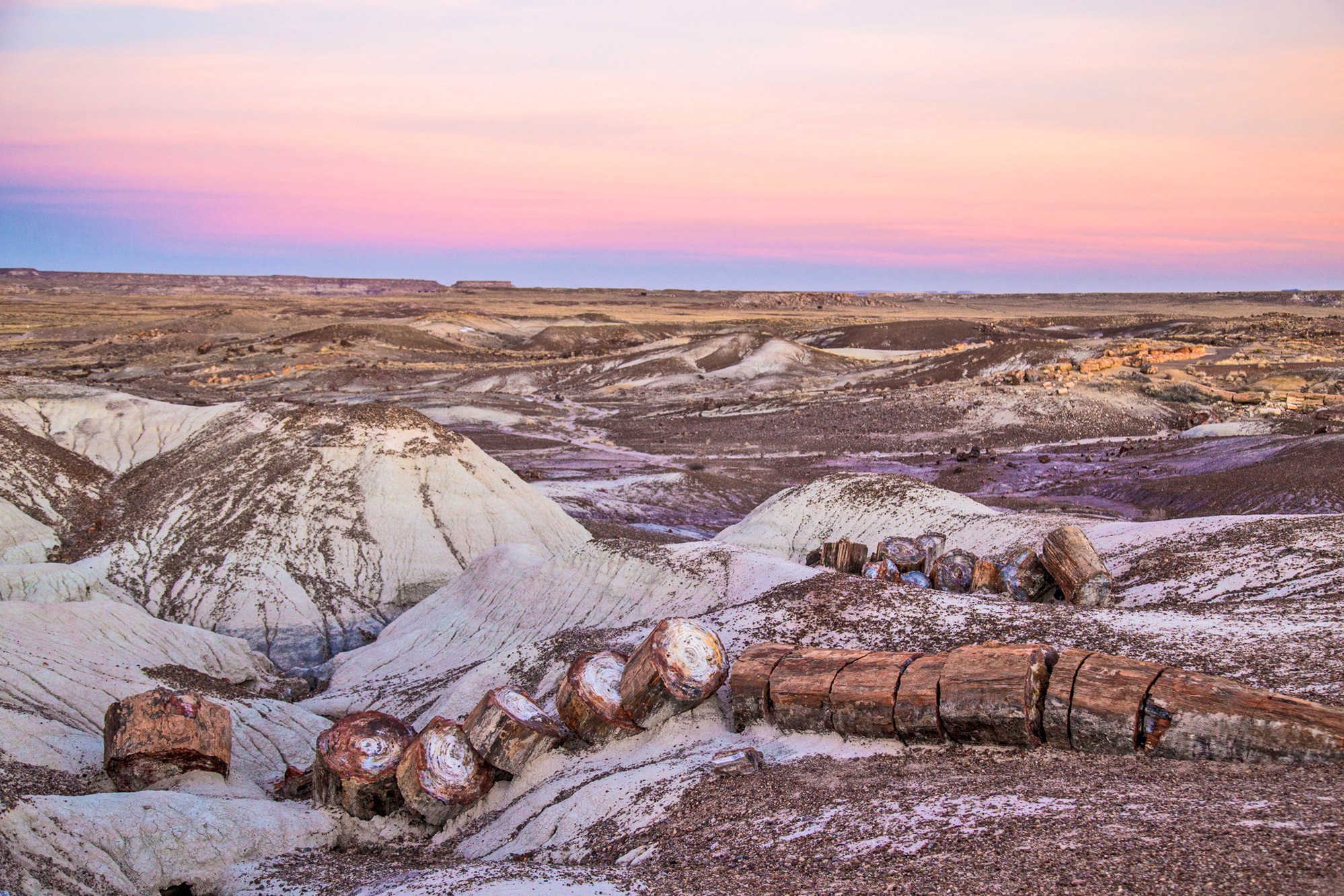
As Chinle Formation sediments around them erode, a couple of 225-million-year-old logs break along naturally caused fractures at Crystal Forest in Petrified Forest National Park, Arizona.
Credit: Jacob Holgerson/National Park Service - Studying the mineralized trees provides information about the environmental conditions while the forest thrived in Triassic times including rainfall, drought, fire and insect infestation.
- Another important fossil forest has been exhumed in northern Peru that tells us about the volcanic demise of an Eocene megadiverse forest 39 million years ago.
- Leaves were ripped off the trees as they were broken off and swept into a river valley to be buried within a volcanic ash mudflow.
- As the Andes continued to rise, erosion exposed the fossil logjam for modern researchers.
- Scientists have worked out the diversity of trees that made up the forest by examining the microscopic structure of the petrified wood as compared to modern lowland tropical trees.
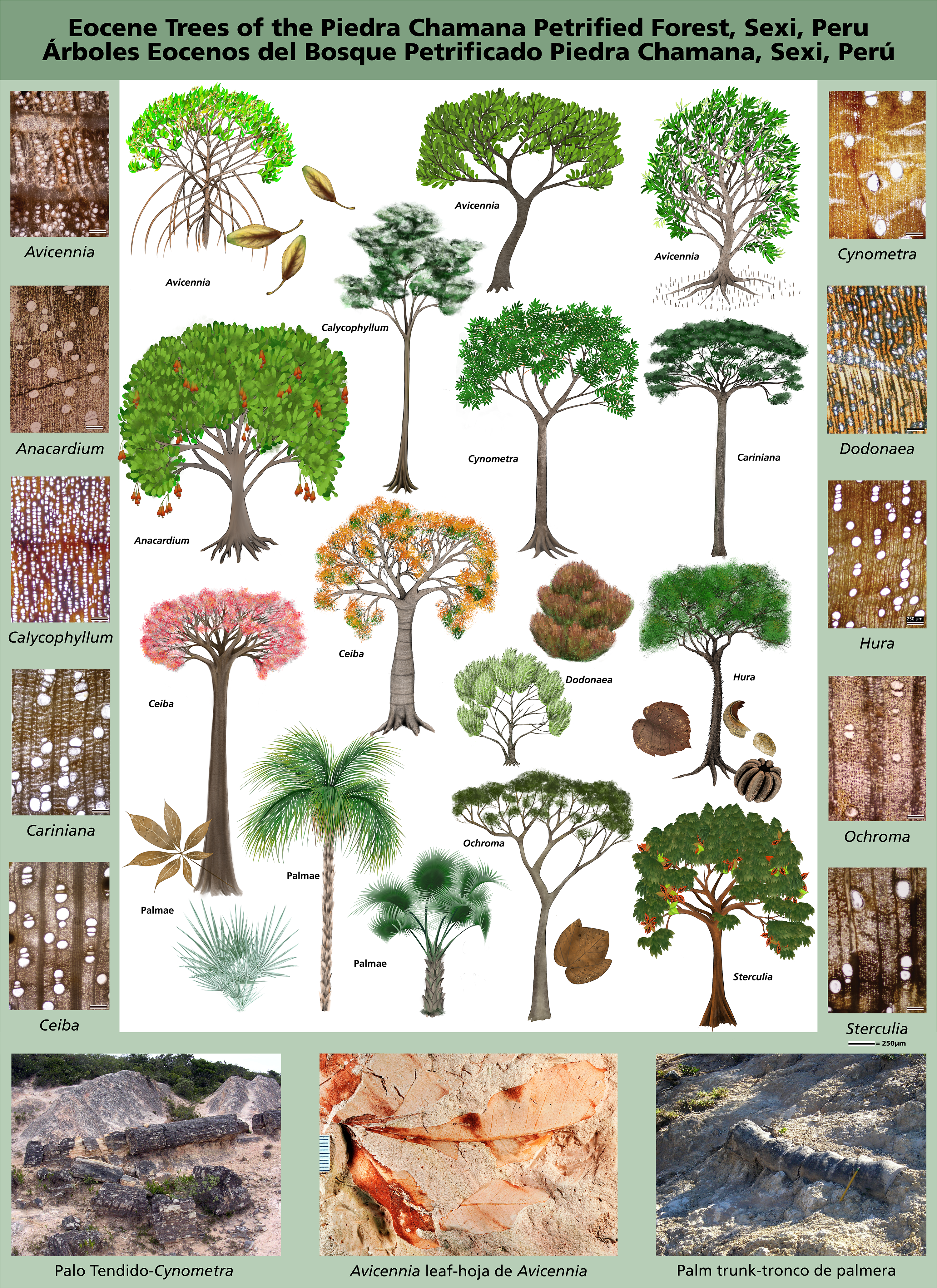
The tree key from northern Peru includes microscopic cross sections of wood that flourished in the region 39 million years ago.
Credit: Mariah Slovacek/Dr. Deborah Woodcock/National Park Service - The presence of leaves with smooth edges suggests a warm climate, and mangrove leaf fossils suggest the river was near the sea.
- Devonian rocks that are about 386 million years old host Earth’s oldest known fossil forest near Cairo, New York.
- Some of these fossils reveal ancient root systems that supported trees in a primeval gymnosperm forest that was buried in a flood.
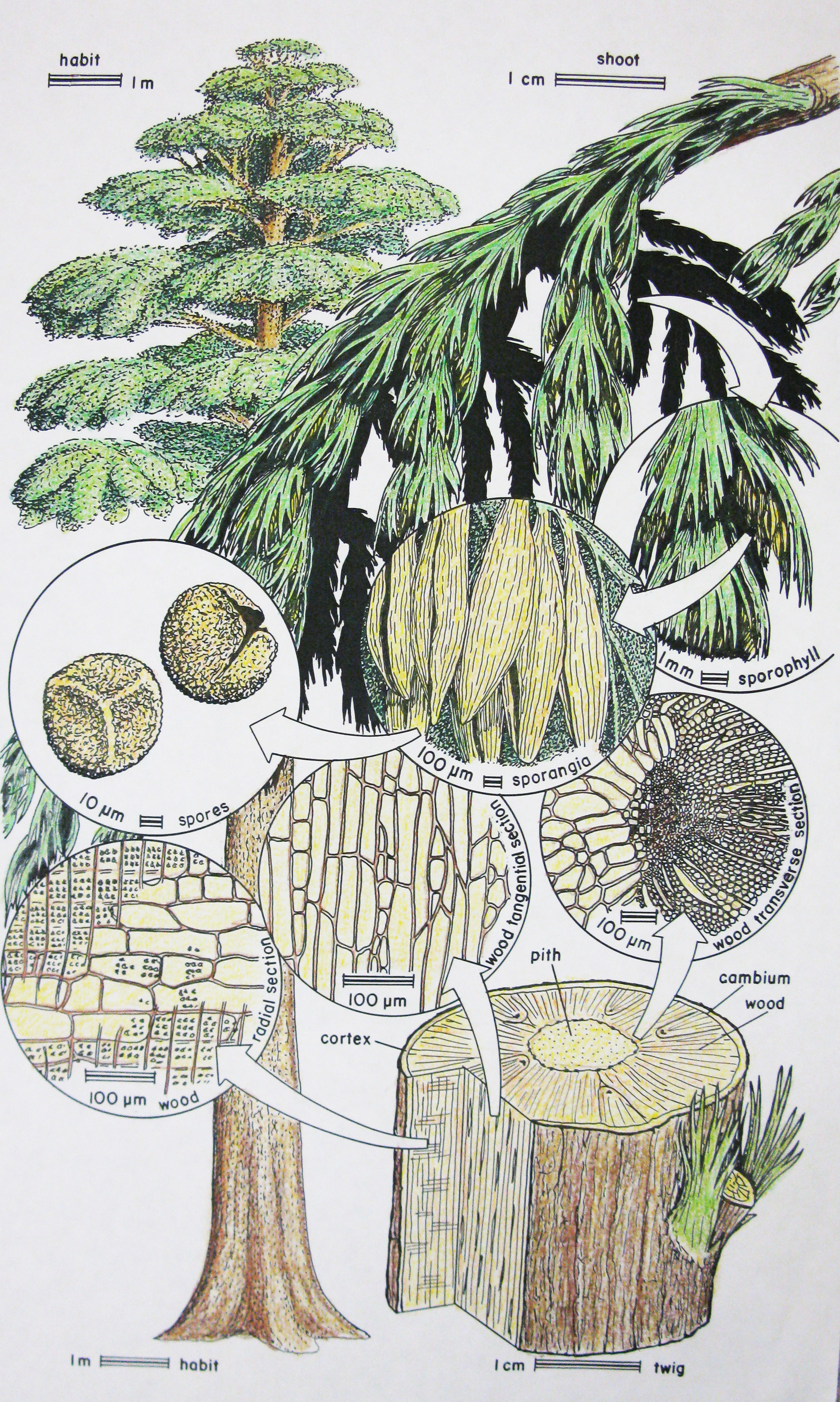
Reconstruction of the extinct tree Archaeopteris based on fossils from the Catskills Mountains of New York.
Credit: Retallack, via Wikimedia Commons - The root system fossils demonstrate, before the rise of seed-producing plants and 150 million years before the rise of dinosaurs, some of Earth’s oldest trees had already evolved extensive branching root systems that resemble modern root systems—a 386-million-year strategy that still works!
- Slightly older trees from a nearby site had simpler root systems that look like those of modern tree ferns.
- Researchers suggest that branching root systems developed in soil that was slightly drier, requiring the roots to stretch farther into the soil for water and nutrients.
- With sturdier anchoring into the soil, trees could grow taller. Roots enabled trees to spread across the planet.
- Some of these fossils reveal ancient root systems that supported trees in a primeval gymnosperm forest that was buried in a flood.
- Petrified forests provide a window into hundreds of millions of years of tree evolution.

